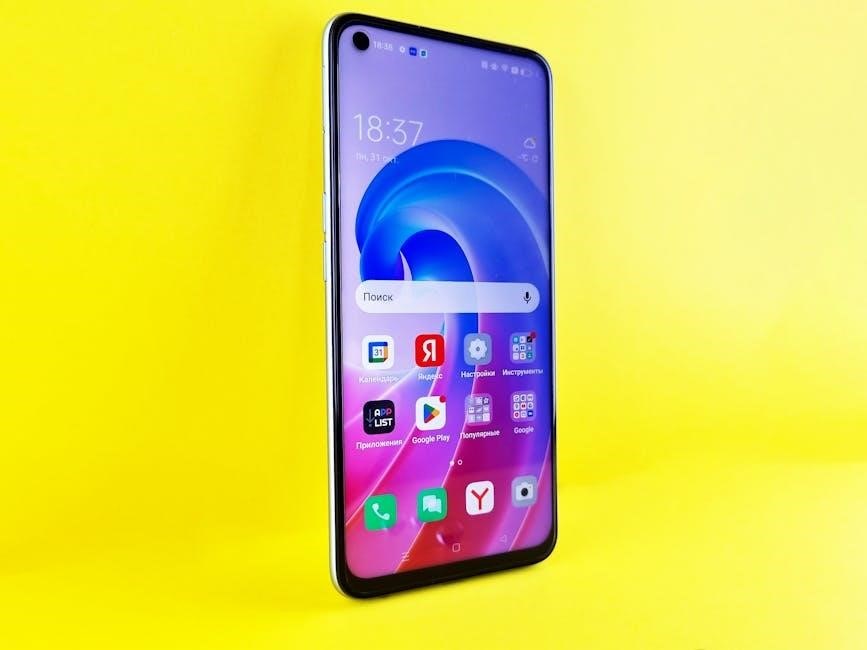
Guided Access on Android‚ also known as app pinning‚ restricts device usage to a single app‚ enhancing focus and preventing accidental navigation. It’s ideal for educational or kiosk setups.
1.1 Definition and Purpose
Guided Access on Android‚ often called app pinning‚ is a feature that restricts the device to a single app‚ preventing navigation to other screens or apps. Its primary purpose is to maintain user focus on a specific task‚ making it ideal for educational environments‚ public kiosks‚ or parental controls. This accessibility feature enhances productivity by limiting distractions and ensuring the device is used as intended.
1.2 Importance of Guided Access
Guided Access is essential for maintaining focus on specific tasks‚ making it vital in educational and professional settings. It ensures device security by restricting unauthorized access and prevents accidental app switching. This feature is particularly valuable for public kiosks‚ educational tools‚ and environments requiring controlled user interaction‚ enhancing productivity and safeguarding sensitive information.

Enabling Guided Access on Android
Guided Access‚ or app pinning‚ is enabled through Android settings‚ typically under Security or Accessibility. A PIN or password is required to exit the pinned app‚ ensuring controlled access.
2.1 Steps to Activate Guided Access
To activate Guided Access on Android‚ go to Settings > Security & Privacy > Other security settings. Enable App pinning and set a PIN or password. Select the desired app‚ then use a gesture (e.g.‚ holding back and recent buttons) to pin it. This restricts the device to the selected app until the PIN is entered to exit.
2.2 Requirements for Activation
To activate Guided Access‚ your Android device must run Android 6.0 or later. Ensure App pinning is enabled in Settings > Security & Privacy > Other security settings. A PIN or password is required for secure access. Some devices may need additional steps‚ such as enabling accessibility features or granting administrative privileges. Check your device’s manual for specific requirements.
Using Guided Access
Guided Access allows you to pin a single app‚ restricting navigation to other screens until a PIN or password is entered‚ ideal for focused or educational use.
3.1 Pinning an App
Pinning an app in Android Guided Access restricts the device to a single application‚ preventing users from accessing other features. This is achieved by enabling app pinning in settings‚ selecting the desired app‚ and securing it with a PIN or password to maintain focus and limit distractions during use. It’s particularly useful for educational or kiosk environments.
3.2 Navigating Within the Pinned App
Within a pinned app‚ users can navigate freely‚ interacting with its features as usual. However‚ exiting or switching apps requires entering the set PIN or password. This ensures the device remains focused on the selected app‚ maintaining productivity and preventing unintended actions. Accessibility features like touch gestures can further enhance navigation within the pinned application.

Managing Guided Access Sessions
Guided Access sessions allow users to restrict device interaction to a single app‚ enhancing focus and productivity. Sessions can be easily started and ended with a PIN or gesture.
4.1 Starting a Guided Access Session
To initiate a Guided Access session on Android‚ users must enable app pinning via Settings > Security > App pinning. Once activated‚ select the desired app‚ hold the recent apps button‚ and enter the PIN or gesture to lock the device to that app‚ ensuring focused usage and preventing unintended navigation.
4.2 Ending a Guided Access Session
To exit Guided Access‚ press and hold the Recent Apps button or enter the designated PIN/password. This unlocks the device‚ allowing navigation to other apps. Ensure the session ends securely to regain full device control and prevent unauthorized access. Always verify the PIN setup for added security when ending a session.
Security Features
Guided Access on Android offers robust security features‚ including PINs and touch gestures‚ to prevent unauthorized access and protect sensitive data‚ ensuring a secure environment.
5.1 Setting Up a PIN or Password
Setting up a PIN or password for Guided Access ensures enhanced security. Navigate to Security settings‚ enable app pinning‚ and create a unique PIN or password. This prevents unauthorized access‚ protecting your device and data. A strong credential is essential for maintaining security during Guided Access sessions‚ ensuring only authorized users can exit the pinned app or adjust settings. This feature adds an extra layer of protection‚ combining with touch gestures for seamless yet secure access.
5.2 Using Touch Gestures for Access
Touch gestures provide an intuitive way to manage Guided Access. Users can enable specific gestures‚ like double-tapping or swiping‚ to lock or unlock the feature. This method enhances convenience while maintaining security. Customizable gestures can be set up in device settings‚ offering an alternative to traditional PIN or password entry. This feature is particularly useful for accessibility and streamlined device interaction.
Customization Options
Customization options allow users to tailor Guided Access to their needs‚ adjusting settings like app behavior and interaction limits. These features enhance both usability and security‚ ensuring a seamless experience.
6.1 Adjusting Settings for Guided Access
Adjusting settings for Guided Access enhances customization‚ allowing users to fine-tune app behavior and interaction limits. Options include enabling app pinning‚ setting passwords‚ and restricting navigation. These settings ensure a secure and focused environment‚ improving both productivity and user experience. By tailoring these preferences‚ users can optimize Guided Access to meet specific needs‚ making it more efficient for various scenarios.
6.2 Configuring Accessibility Features
Configuring accessibility features in Guided Access enhances usability for users with specific needs. Options like enabling touch gestures‚ adjusting sensitivity‚ and customizing interaction settings ensure seamless navigation. These features can be tailored to individual preferences‚ improving overall accessibility and user experience. By integrating accessibility tools‚ Guided Access becomes more versatile‚ catering to a broader range of users while maintaining focus on the pinned application.

Troubleshooting Common Issues
Troubleshooting common issues with Guided Access on Android involves resolving activation problems and addressing app compatibility. Ensure proper setup and check for software updates to maintain functionality.
7;1 Resolving Activation Problems
To resolve activation issues with Guided Access‚ ensure the feature is enabled in Settings under Security or Accessibility. Restart your device‚ check app compatibility‚ and verify PIN or password settings. If issues persist‚ clear cache or update your Android OS to the latest version for optimal functionality and security.
7.2 Fixing App Compatibility Issues
Some apps may not function properly with Guided Access. To fix this‚ check the app’s settings to ensure it supports the feature. Disable any conflicting overlays or accessibility services. Updating the app or Android OS often resolves compatibility issues. If problems persist‚ test with different apps to identify specific conflicts and contact developer support for further assistance.
Comparisons with Other Platforms
Guided Access on Android‚ known as app pinning‚ differs from iOS’s Guided Access‚ which uses triple-click gestures and additional security features for enhanced control.
8.1 Guided Access vs. iOS
Android’s Guided Access‚ or app pinning‚ differs from iOS’s Guided Access‚ which uses triple-click gestures. Android requires a PIN/password‚ while iOS offers more built-in security features. Both aim to restrict app navigation but vary in activation methods and functionality.
8.2 Differences in Functionality
Android’s Guided Access focuses on app pinning‚ requiring a PIN/password to exit‚ while iOS offers more advanced features like touch gestures for navigation. iOS provides built-in accessibility tools‚ whereas Android relies on third-party apps for additional functionality. Android’s setup is more straightforward‚ but iOS offers a smoother‚ more integrated experience‚ making it preferable for users seeking enhanced security and ease of use.
Use Cases and Applications
Guided Access is ideal for kiosk setups‚ educational environments‚ and single-app scenarios‚ ensuring focused usage and minimizing distractions in both personal and professional contexts effectively.
9.1 Educational Settings
Guided Access is highly beneficial in educational environments‚ allowing teachers to lock devices to a specific app during lessons. This minimizes distractions‚ ensuring students remain focused on educational content. It also supports users with special needs by creating a structured‚ single-task interface‚ promoting better engagement and learning outcomes in the classroom.
9.2 Business and Productivity
Guided Access enhances productivity in business settings by allowing employees to focus on specific tasks. It restricts devices to a single app‚ reducing distractions and ensuring work remains uninterrupted. This feature is particularly useful for kiosk setups‚ point-of-sale systems‚ or environments where single-tasking is essential‚ helping businesses maintain efficiency and streamline operations.

Best Practices
Set a secure PIN or password for Guided Access to prevent unauthorized exit. Regularly review and optimize pinned apps for improved performance and user experience.
10.1 Securing Your Device
Securing your device with Guided Access on Android involves setting a strong PIN or password to prevent unauthorized access. This feature restricts the device to a single app‚ ensuring users cannot navigate away without entering the correct credentials. Regularly updating your password and using complex combinations enhances security. This prevents accidental or intentional exit from the pinned app‚ maintaining focus and privacy.
10.2 Optimizing App Performance
Optimizing app performance in Guided Access involves ensuring the pinned app runs smoothly. Close unnecessary background apps to free up memory and CPU resources. Enable automatic updates for the app to ensure it’s optimized with the latest features. Regularly check device storage to prevent low storage issues. Adjust app settings‚ like turning off animations or background data‚ to enhance performance during guided sessions.
Advanced Features
Advanced features in Guided Access include multi-user support‚ allowing different profiles‚ and integration with accessibility tools for enhanced usability‚ ensuring a tailored experience for diverse needs.
11.1 Multi-User Support
Multi-user support in Guided Access allows different profiles to be created‚ each with unique settings and restrictions. This feature is particularly useful in shared devices‚ enabling personalized experiences while maintaining security. Users can switch profiles seamlessly‚ ensuring that each individual’s access remains limited to their designated apps and functionalities‚ enhancing both productivity and privacy.
11.2 Integration with Other Accessibility Tools
Guided Access on Android seamlessly integrates with other accessibility tools‚ such as screen readers and voice commands‚ to enhance user experience. This integration allows users to customize their interactions‚ ensuring a more inclusive and controlled environment. By combining these tools‚ individuals can enjoy a more seamless and accessible experience‚ tailored to their specific needs and preferences.
User Feedback and Reviews
Users praise Guided Access for its simplicity and effectiveness in maintaining focus‚ though some note limited customization options for advanced use cases.
12.1 Positive Experiences
Users highlight Guided Access as a valuable tool for maintaining focus and accessibility. Its simplicity in pinning apps and preventing unintended navigation makes it ideal for educational and single-app kiosk setups.
12.2 Areas for Improvement
Some users note that Guided Access lacks customization options and can be restrictive for advanced users. Compatibility issues with certain apps and the need for a more intuitive setup process are also highlighted as areas needing refinement.
Developer Insights
Developers can utilize Android’s app pinning feature to create focused‚ secure experiences. User feedback plays a crucial role in refining these implementations for better accessibility and functionality.
13.1 Building Apps for Guided Access
Developers can create apps optimized for Guided Access by focusing on single-task environments. Implementing PIN or password protection ensures security. Integrating accessibility features enhances user experience‚ making apps suitable for kiosk or single-app modes. This approach streamlines functionality‚ reducing distractions and improving productivity‚ especially in educational or business settings where focus is critical.
13.2 Developer Tools and Resources
Android Studio and the Android SDK provide essential tools for developing Guided Access-compatible apps. APIs for app pinning and security features enable seamless integration. Developers can leverage accessibility libraries to enhance user interaction. Detailed documentation and sample codes on the Android Developers website guide implementation; Regular updates ensure compatibility with the latest Android versions‚ empowering developers to create secure and user-friendly single-app experiences.
Future Updates and Enhancements
Future updates aim to enhance app pinning with improved security‚ usability‚ and integration with accessibility tools‚ ensuring a more robust and user-friendly Guided Access experience on Android.
14.1 Upcoming Features
Future updates to Guided Access on Android may include enhanced multi-user support‚ advanced app restrictions‚ and improved integration with accessibility tools. These features will aim to provide a more seamless and secure experience‚ catering to both individual and organizational needs. Developers are also exploring AI-driven optimizations to make the feature more intuitive and efficient for users.
14.2 Community Requests
Users have expressed interest in expanded customization options and better compatibility with third-party apps. Requests include advanced time limits‚ improved gesture controls‚ and enhanced security features. The community also hopes for more detailed usage analytics to monitor productivity. These suggestions aim to make Guided Access more versatile and user-friendly‚ addressing diverse needs across different scenarios and device types effectively.
Alternatives to Guided Access
Alternatives include third-party apps like Screen Pinning or Kiosk Browser‚ which offer similar functionality. Built-in features such as Android’s app pinning also provide restricted app access effectively.
15.1 Third-Party Apps
Third-party apps like Screen Pinning and Kiosk Browser offer robust alternatives to Guided Access. These apps provide features like app pinning‚ password protection‚ and restricted access‚ ensuring focused usage. They are ideal for businesses and educational settings‚ offering customization options to enhance productivity and security. While effective‚ they may require additional setup and have varying compatibility across Android devices.
15.2 Built-In Android Features
Android offers built-in features like app pinning‚ which restricts device usage to a single app. This feature enhances focus by preventing accidental navigation. To enable it‚ users can access settings‚ select security options‚ and activate app pinning. It requires a PIN or password to exit‚ ensuring security. This built-in solution is ideal for educational or kiosk setups‚ providing a seamless and secure experience without needing third-party apps.
Guided Access on Android simplifies app management‚ enhancing focus and security. Ideal for education and business‚ it ensures productivity while maintaining accessibility‚ making it a valuable tool.
16.1 Summary of Key Points
Guided Access on Android‚ known as app pinning‚ restricts device usage to a single app‚ enhancing focus and security. Activation involves enabling the feature in settings‚ selecting the app‚ and securing it with a PIN. It offers customization options like toggling features and setting time limits. Ideal for education‚ kiosks‚ and business‚ it ensures productivity while maintaining accessibility and control over device usage.
16.2 Final Thoughts and Recommendations
Guided Access on Android is a powerful tool for enhancing productivity and security by restricting app usage. It is highly recommended for educational‚ business‚ and parental control scenarios. Regularly review and update PINs for added security. Explore customization options to maximize its potential‚ and consider combining it with other accessibility features for a seamless experience tailored to specific needs.